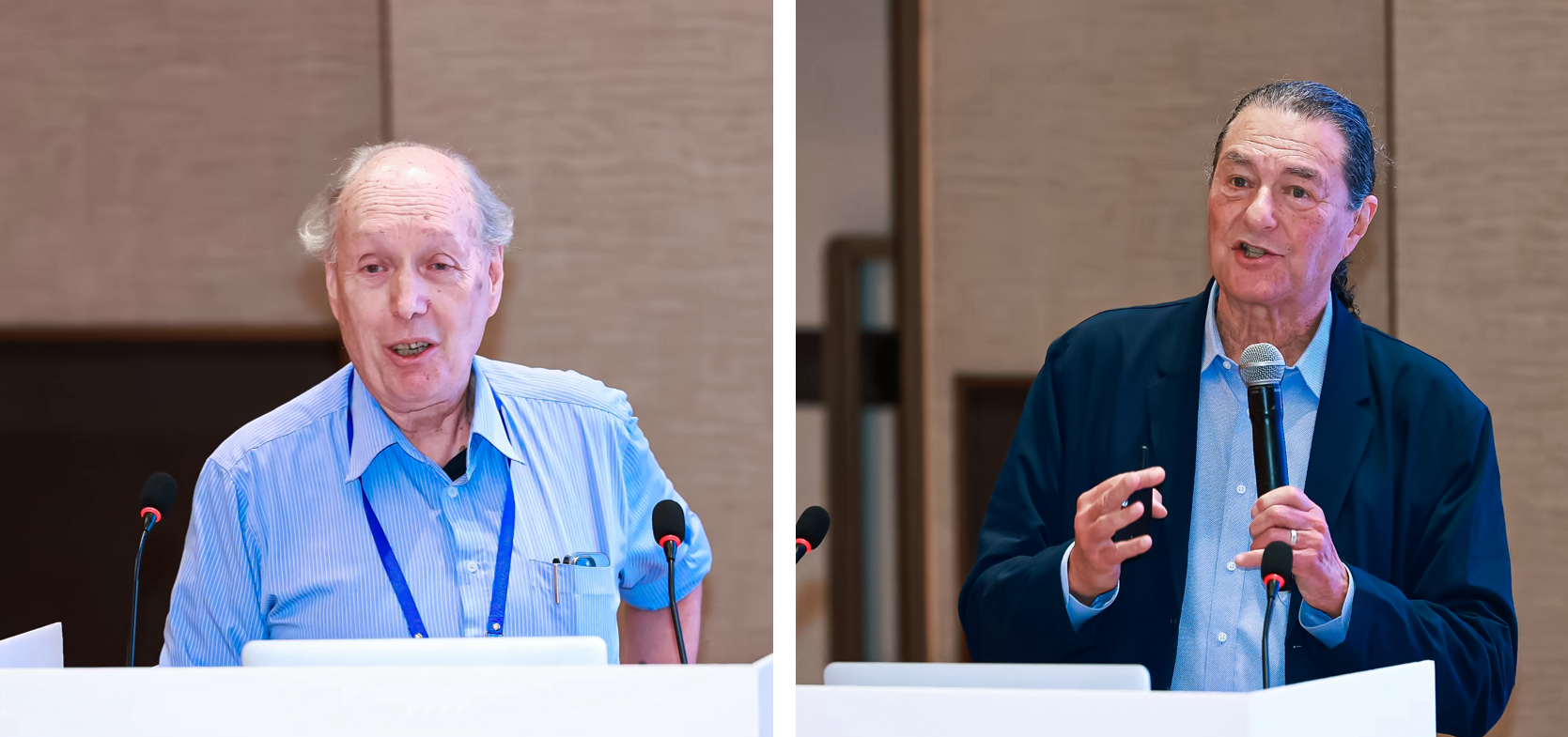The SMART Symposium on Early Diagnosis and Intervention of Alzheimer's Disease, co-organized by SMART and the Shenzhen Bay Laboratory (SZBL), took place successfully in Guangming, Shenzhen, from September 22 to 24, 2024. This event signified the kickoff of the 2024 SMART Symposia academic series, drawing more than forty top international experts and many researchers to this important academic assembly. The symposium wrapped up on September 24, after a range of engaging presentations and discussions.
Led by SZBL PI Tengfei Guo, alongside Professor William Jagust from UC Berkeley, Professor Michael Weiner from UCSF, Professor Ying Han from Xuanwu Hospital affiliated to Capital Medical University, Researcher Fang Xie from Huashan Hospital affiliated to Fudan University, and Professor Keqiang Ye from Shenzhen University of Advanced Technology, the symposium emphasized the prompt detection and successful intervention of Alzheimer’s disease. The event sought to increase awareness and enhance understanding of this condition among the general public and professionals alike.

From left to right: Tengfei Guo, William Jagust, Michael Weiner, Ying Han, Fang Xie, Keqiang Ye
At the symposium, specialists discussed recent progress in the early diagnosis and treatment of Alzheimer’s disease, addressing subjects like the APOE risk gene, discovery of biomarkers, applications of imaging technology, and the significance of multidisciplinary collaboration in clinical settings. The committee additionally organized a special session for emerging scholars, motivating them to demonstrate their enthusiasm and potential in academia. All attendees participated in conversations regarding Alzheimer's disease groups globally, early detection and intervention methods, as well as the application of new technologies to facilitate early screening and tailored treatment.
Professor Leslie M. Shaw, Chief Scientist at the ADNI (Alzheimer's Disease Neuroimaging Initiative) Fluid Biomarker Center at the University of Pennsylvania, presented an online lecture regarding the plasma biomarker p-tau217, emphasizing its considerable importance for early diagnosis and avenues for broader application.

Professor Leslie M. Shaw delivering his online presentation
Professor Colin Masters from the University of Melbourne, a founding member of the AIBL cohort and a significant discoverer of Aβ1-42, talked about his research and perspectives on Alzheimer’s pathology, early detection, and intervention. At the same time, Professor Michael Weiner from UCSF, the Chief Scientist of the ADNI cohort, discussed the developmental phases and important studies related to the ADNI database.

Left: Colin Masters; Right: Michael Weiner
Moreover, specialists in APOE gene research, Professor Guojun Bu from Hong Kong University of Science and Technology and Professor Yadong Huang from UCSF, shared advancements concerning early diagnosis and treatment approaches for Alzheimer’s. Professor Karen Ashe of the University of Minnesota presented her recent discoveries on the effects of tau protein cleavage on different dementia pathologies and examined the therapeutic possibilities of Caspase-2 inhibitors for enhancing memory.
Professor William Jagust of UC Berkeley, the Chief Scientist at the ADNI PET Center, offered insights and the most recent developments in Alzheimer's neuroimaging. Professor Clifford Jack of the Mayo Clinic, Chief Scientist at the ADNI MRI Center, spoke about the revised standards for Alzheimer's diagnosis. He is the originator of the 2018 and 2024 “NIA-AA International Guidelines for Alzheimer's Disease” and the developer of the Jack Curve that illustrates AD progression.

Left: William Jagust; Right: Clifford Jack
Professor Guojun Bu from Hong Kong University of Science and Technology and Professor Yadong Huang from UCSF further elaborated on APOE risk gene research. Professor Karen Ashe from the University of Minnesota highlighted her research on tau protein cleavage and its implications for various dementia pathologies, focusing on Caspase-2 inhibitors as a promising treatment for improving memory.

Left: Yadong Huang; Center: Karen Ashe; Right: Guojun Bu
Other researchers in the field presented recent progress in early diagnosis and treatment, emphasizing advancements in digital biomarkers, ocular imaging technology, fluid biomarkers, risk genes, MRI, and PET imaging. A series of discussions explored Alzheimer's cohort development, early diagnostic techniques, and intervention strategies.

Left to right: Professor Takeshi Iwatsubo from the University of Tokyo, Professor Vincent Mok from the Chinese University of Hong Kong, Professor Roger Gunn from Imperial College London, Professor Yanjian Wang from the Army Medical University, Professor Yun Xu and Professor Bing Zhang from Nanjing Drum Tower Hospital at Nanjing University

Left to right: Professor Lu Shen from Xiangya Hospital of Central South University, Professor Keqiang Ye from the Shenzhen Institute of Technology, Professor Yamei Tang from Sun Yat-sen Memorial Hospital, Professor Susan Landau from UC Berkeley, Professor Jintai Yu from Huashan Hospital of Fudan University, Professor Suzanne Baker from Lawrence Berkeley National Laboratory, and Professor Yao Li from Shanghai Jiao Tong University
The symposium included a dedicated session for emerging scholars. Emerging researchers from the Army Medical University, Central South University, Shanghai Jiao Tong University, Zhejiang University, Fujian Medical University, Capital Medical University, Peking University Shenzhen Hospital, Beijing Normal University, the University of Tokyo, and Shenzhen Bay Laboratory showcased their recent discoveries. Their efforts garnered insightful feedback from both international and local experts, igniting lively discussions among participants.


First row: Yue Cai and Guoyu Lan from Shenzhen Bay Laboratory, Bin Jiao from Xiangya Hospital of Central South University, and Jiawei Xin from Union Hospital of Fujian Medical University.
Second row: Yi Ling from the First Affiliated Hospital of Zhejiang University School of Medicine, Mingkai Zhang from Xuanwu Hospital of Capital Medical University, Yaojing Chen from Beijing Normal University, Binyin Li from Ruijin Hospital affiliated with Shanghai Jiao Tong University School of Medicine, and Ying Luan from Zhongda Hospital affiliated with Southeast University.
Third row: Moto Nakaya from the University of Tokyo, Xiang Fan from Peking University Shenzhen Hospital, Rui Zhou from Tsinghua University, and Qi Huang from Huashan Hospital affiliated with Fudan University.
The symposium drew inspiration from the meeting format of the Alzheimer’s Association International Conference (AAIC), incorporating ample discussion sessions. The invited speakers were leading experts in both clinical and basic research fields, providing attendees with a truly international academic exchange experience. At SMART Symposia, researchers benefit from engaging scholarly discussions, and young scholars receive valuable guidance and advice from senior researchers. The sharing of successful cases and practical experiences by global scholars offered a wealth of knowledge and inspiration, fostering international collaboration and innovation.
The event promoted significant scholarly interactions between fundamental research scientists and clinicians in the area of Alzheimer’s disease. It is anticipated to enhance cooperation among researchers globally in the early detection and treatment of Alzheimer’s disease.
In conclusion, the organizing committee thanked everyone for their enthusiastic support and proactive involvement. During the short yet intense two-day conference, the commitment of all researchers working to enhance the lives of Alzheimer’s patients was clear. We can't wait to reunite with everyone at the upcoming SMART Symposium!
